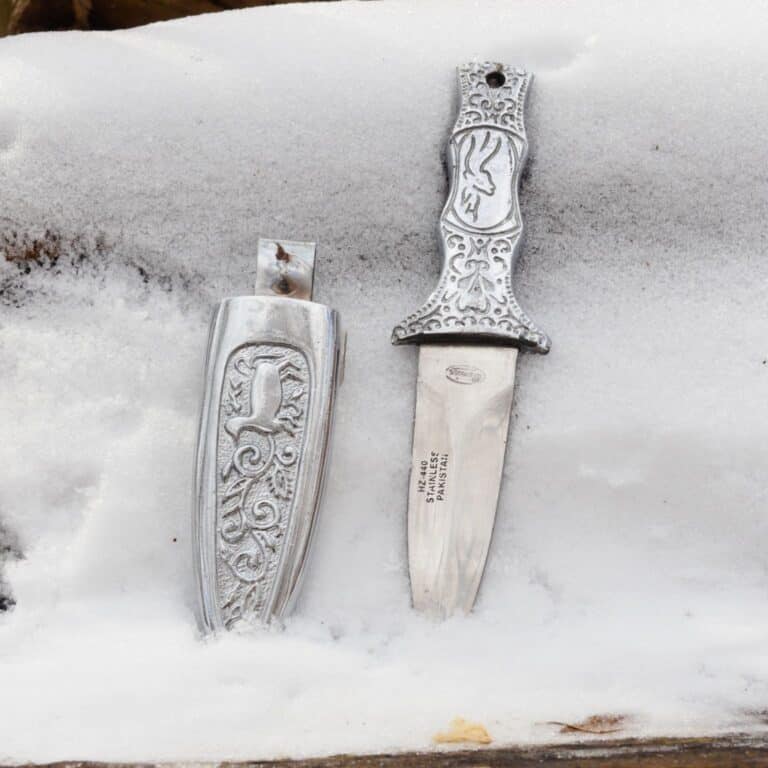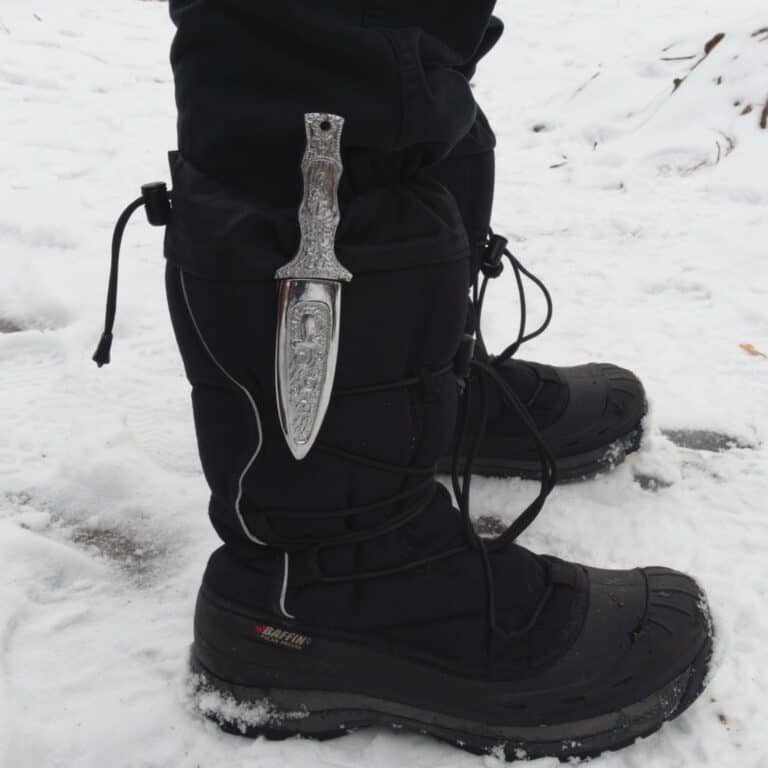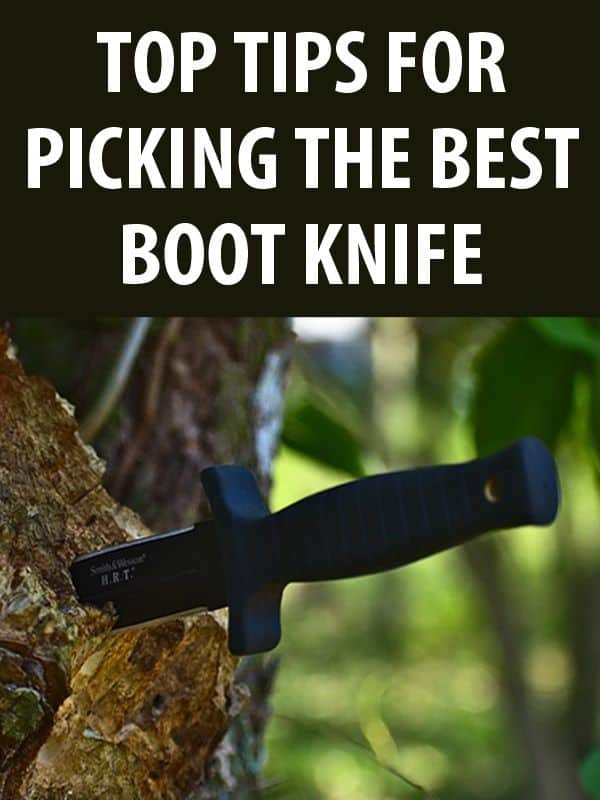Author Bio: I am John Lewis, a blogger, survivalist and outdoor enthusiast. You can follow me over at Epic Wilderness by clicking here.
Nowadays, boot knives are starting to fall under the limelight because they are usually small, easily concealable and are not too pricey.

These characteristics also makes it really good for self-defense purposes where people who threaten you cannot see what is coming.
There are still some common mistakes you have to avoid while using a boot knife to optimize it for your survival.
This includes storing the boot knife in a place which is convenient for you to access in light of the clothing you wear, understanding clearly why you hold a boot knife in the first place and avoid making it too uncomfortable for yourself especially when you are going to move a lot with it.
To be better prepared as well, you need a good blade which is great for you to conceal and would be able to fulfill your needs too such as by causing sufficiently deep cuts. This is where getting some tips and knowing what to look for in a boot knife is essential.
Before going on any further, allow me to recommend some boot knives, so that the following tips can be better illustrated.
Disclosure: This post has links to 3rd party websites, so I may get a commission if you buy through those links. Survival Sullivan is a participant in the Amazon Services LLC Associates Program. As an Amazon Associate, I earn from qualifying purchases. See my full disclosure for more.
- Kershaw Secret Agent Concealable Boot Knife
- Master USA MU-1121 Series Tactical Fixed Blade Neck Knife
- Smith & Wesson Stainless Steel Fixed Blade
Get a boot knife with the right blade-point
It is vital that you get a knife with the most suitable blade-point design because it would affect how you should use the knife in different situations. Also, the current choices of blade-point designs are several, which means there may be some blade-point designs which I missed out describing here.
Generally, blades a shallow belly are usually made for stabbing while blades with a deep belly are made for slashing. Also, double edged blades with ‘spearpoints’ are usually made for stabbing, while single edged blades with clip points are usually designed for slashing.
First, one of the more popular blade-point design is the straight-back blade where the back portion of the knife have a straight edge. These knives are similar to those which you use in the kitchen. This blade-point design is great for chopping or slicing things up, which includes chopping your vegetables!
Second, would be the sheepsfoot blade which looks literally like what it sounds, like a sheep’s foot. This kind of blade is perfect if you would like to slice and cut while you still have sufficient control over the blade point.
Emergency responders usually use a sheepsfoot blade to cut through things which restraint the victim’s movement without harming them, such as cutting a seatbelt.
Third, is the spear-point blade where the blade is made to be symmetrically pointed, where the blade-point is in the same line as the center of the blade. These kinds of blades are great for piercing things, where you can also say that these can work as great throwing knives.
Also, most boot knives that you see in the market are sharpened on both ends, which I would suggest getting only when you are experienced at handling knives. If you are still new to this, it would be better to get a knife with only one sharpened edge.
Getting a boot-knife with a strong blade
Usually, we would opt for full tang knives because they are usually much stronger where they won’t easily snap from the handle.
The tang is the area where the blade and the handle of the knife are attached. Full tang knives basically mean that the blade covers the whole length and width of the knife’s handle, which is the most durable form of construction.
If you chose a blade that is smaller in size, you may want to ensure that it is made from strong materials such as carbon steel.
Another term for a blade that is shorter and narrower than the handle is called a partial tang, which is highly discouraged. This is because such blades which are small and made from fragile materials tend to bend and break.
Another thing you may want to consider is getting a knife with a coated blade. These coatings help reduce the rate of rusting and allows you to maintain it easily.

Ensuring that the knife is suitable for your boots
It would be wise to always store the knife in a sheath because they are designed to stop the knife from causing damage to anything in contact with it.
Since you are storing in your boots, you do not want to risk hurting your feet. You can even look into sheaths that consist some kind of a locking mechanism which prevents the knife to easily get disengaged.
There are some manufacturers which produces boots made to store boot knives, which is usually the case for hunting boots.
These boots often have special straps and built-in compartments, which allows you to easily store the knife safely. If this is not the case, you have to be creative and find ways to strap the sheath on your boots while concealing it.
If your boots are not made to store such knives, it would be wise to get a boot-knife with medium sized blade. A knife with a large blade may cut through the sheath and eventually hurt your leg.
Since you have a large amount of options to choose from, you can always test it out to ensure that it is easy for you to unsheathe the knife and it does not hinder your movement too much.
Ideally, you can find a knife and a sheath which allows you to easily access, giving you an edge when a situation arises which requires you to use it.
Make sure that the length of the blade is suitable for you
This tip is interrelated to tip 3, in the sense that a longer blade would be harder to fit in your boots. So, if your boots are not made to store knives and the amount of space is limited, it would be better to get a knife with a short blade. The drawback is that smaller blades may not be able to be as effective as long blades in certain situations.
There are altogether three categories of blade lengths: large blades, medium blades and short blades. There are different uses and advantages for each category.
Short blades are those below 2.75 inches, where it would be easier to conceal in comparison with those blades that has longer lengths.
Even if you decide to clip them on your boots, it is still ‘concealed’, because most people would not be able to notice it anyway. Further, short blades weigh lighter which makes it easier for movement, and this usually involve situations where you go for hunting.
Concerning medium-sized blades, these are between 2.75 and 4 inches. At this size, it is large enough to cause deep cuts while being small enough for you to conceal it and carry it around.
Moving on to large blades, which are above 4 inches, are usually harder to conceal due to it being larger in size exposing the areas which can cut to larger portions of your feet.
This would still be the best one for self-defense since you can cause the deepest wound with this length, if you can conceal it properly of course. Other aspects would include being able to cut wood or other things more efficiently due to the length of the blade.
A handle that is made from durable material and has great texture
What the handle is made of and the shape of it would affect how comfortable you feel when you hold it. The aim is to get a handle that allows you to have a good grip over the blade in most situations, while ensuring that it is strong enough to withstand harsh treatment.
As of now, you can choose to have stainless-steel handles or even Titanium handles. If you opt for stainless steel handles, they are great because of its durability and its ability to withstand corrosion. The only downside is that it may weigh you down restraining your movement.
As for titanium handles, it may be costlier, but it would be both durable and would weigh less. You can invest on a boot knife with this handle if you have extra cash to spare.
Conclusion
Having a boot knife for people in this preparedness journey would ultimately be for self-defense purposes. However, there are many other purposes you can use it for which optimizes the value you can get for it.
First, it can help you to clear your path by cutting down woods, bushes and thickets. However, it is still preferable to use large knives such as a kukri for this purpose.
Next, would be using it while hunting to gather food where you can even attach the knife to a stick to make it a ‘spear’. Finally, you can use your survival knife to prepare firewood because most of them are sharp enough to split wood.
Getting a good boot knife is only the beginning, there is still a need to keep your mind open and learn different ways to use it! There are 2 aspects which you can go in-depth, one, the uses of a boot knife and two, the ways you have for concealing it.


My dad was military. My grandfather was a cop. They served their country well. But I don’t like taking orders. I’m taking matters into my own hands so I’m not just preparing, I’m going to a friggin’ war to provide you the best of the best survival and preparedness content out there.

I’m assuming a boot knife is meant to be concealed for use as a back-up. An expensive (used to be waaaay less expensive) was a military pattern bayonet. During WWII, many G.I.s took the Chicago Cutlery pig sticker (double edged spear bladed) knife and made it their own. During Vietnam, the Gerber Mark I – II and similar took over.
Many ideas on how to carry a knife concealed and even in plain view. This is where the internet is your friend – seek military personnel forums to pick and choose ideas. Some very imaginative ways to hide and access a knife quickly.
Interesting topic – I’m interested in the comments, thanks for writing it.
I’m not clear what purpose the boot knife is intended for. There is no knife which is good for every purpose, so the first step is deciding what the knife is FOR. If it is for defense, then the knife chosen needs to be appropriate for the style of knife fighting you will use. If it is for survival tasks, then generally you will want the blade shape which is good or better for most survival tasks (best is a “drop point” without false edge or serrations).
When we say “boot knife” as a class of knife, we are usually talking about a two edged, narrow blade which is really good for stabbing and poor at most other tasks. I’m thinking that in this article, it means “a knife carried in the boot”.
One over sight is the fact that a boot knife is meant to be concealed or at least attached to a boot and sometimes it is hidden under a pant leg. The smaller knives with a 2 inch blade or less can be attached to a boot via the laces if they have holes in the sheath to allow this or the clip works with your boots.
Legally or illegally concealed does not lend itself to easy retrieval as if uncovered. Second, I don’t really get the idea of choosing a boot knife over one attached or worn on a belt, strap, forearm, leg, etc. It’s okay as an extra just like many guys carry a knife in each pocket and/or on a belt as well.